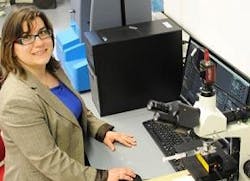Nanoparticle tracking analysis characterizes self-assembled nanomotors
Salisbury, England--Nanoparticle tracking analysis from NanoSight, manufacturer of nanoparticle characterization technology, is being used for the characterization of self-assembled nanomotors by Radboud University Nijmegen (Nijmegen, The Netherlands). Jet-engined nanosized rockets may provide a solution for delivering drug packages in the human body, based on the work of Daniela A. Wilson, Roeland J. M. Nolte, and Jan C. M. van Hest from the Institute for Molecules and Materials (IMM) at Radboud University Nijmegen published in Nature Chemistry.
Daniela A. Wilson explains, "Making a nanomotor has been a dream of many researchers in nanotechnology. From molecular machines to micron size self-propelling rods, our team has used a combination of bottom-up or top-down approaches taking years off synthetic work. We applied self-assembly as a tool just like the pieces of a puzzle. The only difference is that we allowed the building blocks make itself to form 350 nm sized motors. The next step was to prove the concept. Having constructed these sub-micron sized nanomotors, we could not use conventional microscopies to visualize them. For 350 nm size particles, we required a special technique and this is how we have come to be users of the NanoSight technique of nanoparticle tracking analysis, NTA. This tracks the motors one by one [in effect, particle-by-particle]. We could even analyze their movement after the addition of their fuel [hydrogen peroxide]."
Wilson continued, "Knowing the particle size was very important to establish the size distribution of our self-assembled nanomotors as well the entrapment of the catalytic particles inside the bowl shape structures. However, even more important for us was the ability to track the movement of the motors in the presence of the fuel. This provided the definitive proof of directed motion resulting from the fast discharge of oxygen."
Prior to using NTA, the IMM group used dynamic light scattering (DLS), which did not provide the ability to track individual particles that was essential for this research. Furthermore, it was vital to be able to analyze particle movement in real time. NanoSight uses tracking and scattering information to provide the size of the particles as well as giving information about the purity of its components. Different refractive indexes materials within the same colloidal distribution will give different scattering and therefore the group is able to use that information to assess the purity and distribution of complex mixtures.
NanoSight says its "Nanoparticle Tracking Analysis" (NTA) detects and visualizes populations of nanoparticles in liquids down to 10 nm, dependent on material, and measures the size of each particle from direct observations of diffusion. Additionally, NanoSight measures concentration and a fluorescence mode differentiates suitably labeled particles within complex background suspensions. Zeta potential measurements assess the surface charge on particles.
SOURCE: NanoSight; www.malvernpanalytical.com/en/products/product-range/nanosight-range/nanosight-pro
About the Author

Gail Overton
Senior Editor (2004-2020)
Gail has more than 30 years of engineering, marketing, product management, and editorial experience in the photonics and optical communications industry. Before joining the staff at Laser Focus World in 2004, she held many product management and product marketing roles in the fiber-optics industry, most notably at Hughes (El Segundo, CA), GTE Labs (Waltham, MA), Corning (Corning, NY), Photon Kinetics (Beaverton, OR), and Newport Corporation (Irvine, CA). During her marketing career, Gail published articles in WDM Solutions and Sensors magazine and traveled internationally to conduct product and sales training. Gail received her BS degree in physics, with an emphasis in optics, from San Diego State University in San Diego, CA in May 1986.
